Using Edible Plant and Lightweight Expanded Clay Aggregate (LECA) to Strengthen the Thermal Performance of Extensive Green Roofs in Subtropical Urban Areas
Abstract
:1. Introduction
- Investigate the depth of the growth medium;
- Investigate the proportion of LECA in the growth medium;
- Investigate the placement of LECA in the growth medium;
- Investigate how adding Ipomoea batatas affects the thermal performance of extensive green roofs.
- Conduct a weight-reduction-and-cost analysis of extensive LECA roofs.
2. Materials and Methods
2.1. Experiment Site
2.2. Description of Plant Material and Growth Medium
2.3. Experimental Design
2.4. Instrument Settings and Measurement Data
3. Results and Discussion
3.1. Marginal Temperature Reduction When 10, 15, 20, and 25 cm Conventional Garden Soil and No Plants Were Used
3.2. Temperature Reduction When 0%, 10%, 40%, and 70% LECA Were Laid at the Bottom and No Plants Were Used
3.3. Temperature Reduction When 10% and 40% LECA Were Laid at the Bottom without Plants and When 10% and 40% LECA Were Mixed with the Soil without Plants
3.4. Temperature Reduction When 10% and 40% LECA Were Laid at the Bottom with Plants and When 10% and 40% LECA Were Mixed with the Soil with Plants
3.5. Weight-Reduction-and-Cost Analysis of the Extensive Roofs Containing LECA
4. Conclusions
- Because of the evapotranspiration, shading, shielding, reflective, and photosynthetic effects of the vegetation layer, the roofs with Ipomoea batata exhibited significantly higher passive-cooling effects than did the roofs without Ipomoea batata.
- Because of the air pockets inside and between particles in LECA, the roofs with 10% and 40% LECA had slightly greater passive-cooling effects than did the roofs with 0% LECA (conventional garden soil).
- At a slightly different average air temperature (0.56 °C; i.e., 32.04 °C minus 31.48 °C), the combined effects of LECA and Ipomoea batata helped to significantly reduce the average temperature of the bare rooftop by an additional 10.19 °C, or by 106.81% (temperature reduction of the bare rooftop increased from 9.54 °C in 0% LECA without plants in the second stage to 19.73 °C in 10% LECA with plants in the fourth stage).
- LECA reduces the effect of heat-amplitude reduction, whereas Ipomoea batata helps to strengthen this effect. The roofs with 10–40% LECA and Ipomoea batata helped to reduce the heat amplitude of the bare rooftop by approximately 65%.
- Although the 40% and 10% LECA roofs in the second stage demonstrated a similar performance in reducing the temperature of the bare rooftop (only different by 0.63 °C), after irrigation, the roofs with 40% and 10% LECA were able to reduce the weight load by 1606.92 kg (3543.26 lbs, 27 adults) and 401.94 kg (886.28 lbs, 7 adults) per unit building, respectively.
Author Contributions
Funding
Acknowledgments
Conflicts of Interest
References
- Frumkin, H. Beyond toxicity: Human health and the natural environment. Am. J. Prev. Med. 2001, 20, 234–240. [Google Scholar] [CrossRef]
- McEwen, B.S. Protective and damaging effects of stress mediators. N. Engl. J. Med. 1998, 338, 171–179. [Google Scholar] [CrossRef] [PubMed]
- Sluiter, J.K.; Frings-Dresen, M.H.W.; Meijman, T.F.; van der Beek, A.J. Reactivity and recovery from different types of work measured by catechol amines and cortisol: A systematic literature overview. J. Occup. Environ. Med. 2000, 57, 298–315. [Google Scholar] [CrossRef]
- Kaplan, R. Some psychological benefits of gardening. Environ. Behav. 1973, 5, 145–162. [Google Scholar] [CrossRef]
- Ulrich, R.S. Visual landscapes and psychological well-being. Landsc. Res. 1979, 4, 17–23. [Google Scholar] [CrossRef]
- Hartig, T.; Book, A.; Garvill, J.; Olsson, T.; Garlilng, T. Environmental influences on psychological restoration. Scand. J. Psychol. 1995, 37, 378–393. [Google Scholar] [CrossRef]
- Ulrich, R.S.; Simons, R.F.; Losito, B.D.; Fiorito, E.; Miles, M.A.; Zelson, M. Stress recovery during exposure to natural and urban environments. J. Environ. Psychol. 1991, 11, 201–230. [Google Scholar] [CrossRef]
- Van den Berg, A.; Koole, S.L.; Van der Wulp, N.Y. Environmental preference and restoration: (How) are they related? J. Environ. Psychol. 2003, 23, 135–146. [Google Scholar] [CrossRef]
- Heliker, D.; Chadwick, A.; O’Connell, T. The meaning of gardening and the effects on perceived well being of a gardening project on diverse populations of elders. Act. Adapt. Aging 2000, 24, 35–56. [Google Scholar] [CrossRef]
- Liu, T.C.; Shyu, G.S.; Fang, W.T.; Liu, S.Y.; Cheng, B.Y. Drought tolerance and thermal effect measurements for plants suitable for extensive green roof planting in humid subtropical climates. Energy Build. 2012, 47, 180–188. [Google Scholar] [CrossRef]
- Karachaliou, P.; Santamouris, M.; Pangalou, H. Experimental and numerical analysis of the energy performance of a large scale intensive green roof system installed on an office building in Athens. Energy Build. 2016, 114, 256–264. [Google Scholar] [CrossRef]
- Peng, L.L.H.; Jim, C.Y. Green-roof effects on neighborhood microclimate and human thermal sensation. Energies 2013, 6, 589–618. [Google Scholar] [CrossRef]
- Abuseif, M.; Gou, Z. A review of roofing methods: Construction, features, heat reduction, payback period and climatic responsiveness. Energies 2018, 11, 3196. [Google Scholar] [CrossRef]
- My Garden. Family Farm; My House Publishing: Taipei, Taiwan, 2011. [Google Scholar]
- Construction and Planning Agency. Ministry of the Interior, Architectural Regulations: Weight Load Section. Available online: http://w3.cpami.gov.tw/law/law/lawe-2/b-rule.htm/ (accessed on 14 October 2017).
- Dunnett, N.; Nolan, A. The effect of substrate depth and supplementary watering on the growth of nine herbaceous perennials in a semi-extensive green roof. Acta Hortic. 2004, 643, 305–309. [Google Scholar] [CrossRef]
- Papafotiou, M.; Pergialioti, N.; Tassoula, L. Growth of native Aromatic Xerophytes in an extensive Mediterranean green roof as affected by substrate type and depth and irrigation frequency. HortScience 2013, 48, 1327–1333. [Google Scholar]
- Kotsiris, G.; Nektarios, P.A.; Paraskevopoulou, A.T. Lavandula angustisfolia growth and physiology is affected by substrate type and depth when grown under Mediterranean semi-intensive green roof conditions. HortScience 2012, 47, 311–317. [Google Scholar]
- Nektarios, P.A.; Amountzias, L.; Kokkinou, I.; Ntoulas, N. Green roof substrate type and depth affect the growth of the native species Dianthus fruticosus under reduced irrigation regimens. HortScience 2011, 46, 1208–1216. [Google Scholar]
- Ntoulas, N.; Kektarios, P.A.; Spaneas, K.; Kadoglou, N. Semi-extensive green roof substrate type and depth effects on Zoysia matrella “Zeon” growth and drought tolerance under different irrigation regimes. Acta Agric. Scand. Sect. B—Soil Plant Sci. 2012, 62 (Suppl. 1), 165–173. [Google Scholar] [CrossRef]
- Kotsirisa, G.; Nektariosa, P.A.; Ntoulasa, N.; Kargasb, G. An adaptive approach to intensive green roofs in the Mediterranean climate region. Urban Urban Gree 2013, 12, 380–392. [Google Scholar] [CrossRef]
- Lin, Y.J.; Lin, H.T. Thermal performance of different planting substrates and irrigation frequencies in extensive tropical rooftop greeneries. Build. Environ. 2011, 46, 345–355. [Google Scholar] [CrossRef]
- Wanphen, S.; Nagano, K. Experimental study of the performance of porous materials to moderate the roof surface temperature by its evaporative cooling effect. Build. Environ. 2009, 44, 338–351. [Google Scholar] [CrossRef]
- Sutcu, M. Influence of expanded vermiculite on physical properties and thermal conductivity of clay bricks. Ceram. Int. 2015, 41, 2819–2827. [Google Scholar] [CrossRef]
- Central Weather Bureau. Climate Statistics for Temperature. Available online: http://e-service.cwb.gov.tw/HistoryDataQuery/index.jsp/ (accessed on 31 October 2017).
- Boudaghpour, S.; Hashemi, S. A study on light expended clay aggregate (LECA) in a Geotechnical view and its application on greenhouse and greenroof cultivation. Int. J. Geol. 2008, 4, 59–63. [Google Scholar]
- Mun, K.J. Development and tests of lightweight aggregate using sewage sludge for nonstructural concrete. Constr. Build. Mater. 2007, 21, 1583–1588. [Google Scholar] [CrossRef]
- Arioz, O.; Kilinc, K.; Karasu, B.; Kaya, G.; Arslan, G.; Tuncan, M.; Tuncan, A.; Korkut, M.; Kivrak, S. A preliminary research on the properties of lightweight expanded clay aggregate. J. Aust. Ceram. Soc. 2008, 44, 23–30. [Google Scholar]
- Sales, A.; Souza, F.R.; Santos, W.N.; Zimer, A.M.; Almeida, F.C.R. Lightweight composite concrete produced with water treatment sludge and sawdust: Thermal properties and potential application. Constr. Build. Mater. 2010, 24, 2446–2453. [Google Scholar] [CrossRef]
- Zhang, B.; Poon, C.S. Use of furnace ash for producing lightweight aggregate concrete with thermal insulation properties. J. Clean. Prod. 2015, 99, 94–100. [Google Scholar] [CrossRef]
- Song, U.; Kim, E.; Bang, J.H.; Son, D.J.; Waldman, B.; Lee, E.L. Wetlands are an effective green roof system. Build. Environ. 2013, 66, 141–147. [Google Scholar] [CrossRef]
- Huang, Y.Y.; Chen, C.T.; Tsai, Y.C. Reduction of temperatures and temperature fluctuations by hydroponic green roofs in a subtropical urban climate. Energy Build. 2016, 129, 174–185. [Google Scholar] [CrossRef]
- He, Y.; Yu, H.; Dong, N.; Ye, H. Thermal and energy performance assessment of extensive green roof in summer: A case study of a lightweight building in Shanghai. Energy Build. 2016, 127, 762–773. [Google Scholar] [CrossRef]
- Jaffal, I.; Ouldboukhitine, S.E.; Belarbi, R. A comprehensive study of the impact of green roofs on building energy performance. Renew. Energy 2012, 43, 157–164. [Google Scholar] [CrossRef]
- Jim, C.Y.; Peng, L.L.H. Weather effect on thermal and energy performance of an extensive tropical green roof. Urban Urban Gree 2012, 11, 73–85. [Google Scholar] [CrossRef]
- Wong, N.H.; Tan, P.Y.; Chen, Y. Study of thermal performance of extensive rooftop greenery systems in the tropical climate. Build. Environ. 2007, 42, 25–54. [Google Scholar] [CrossRef]
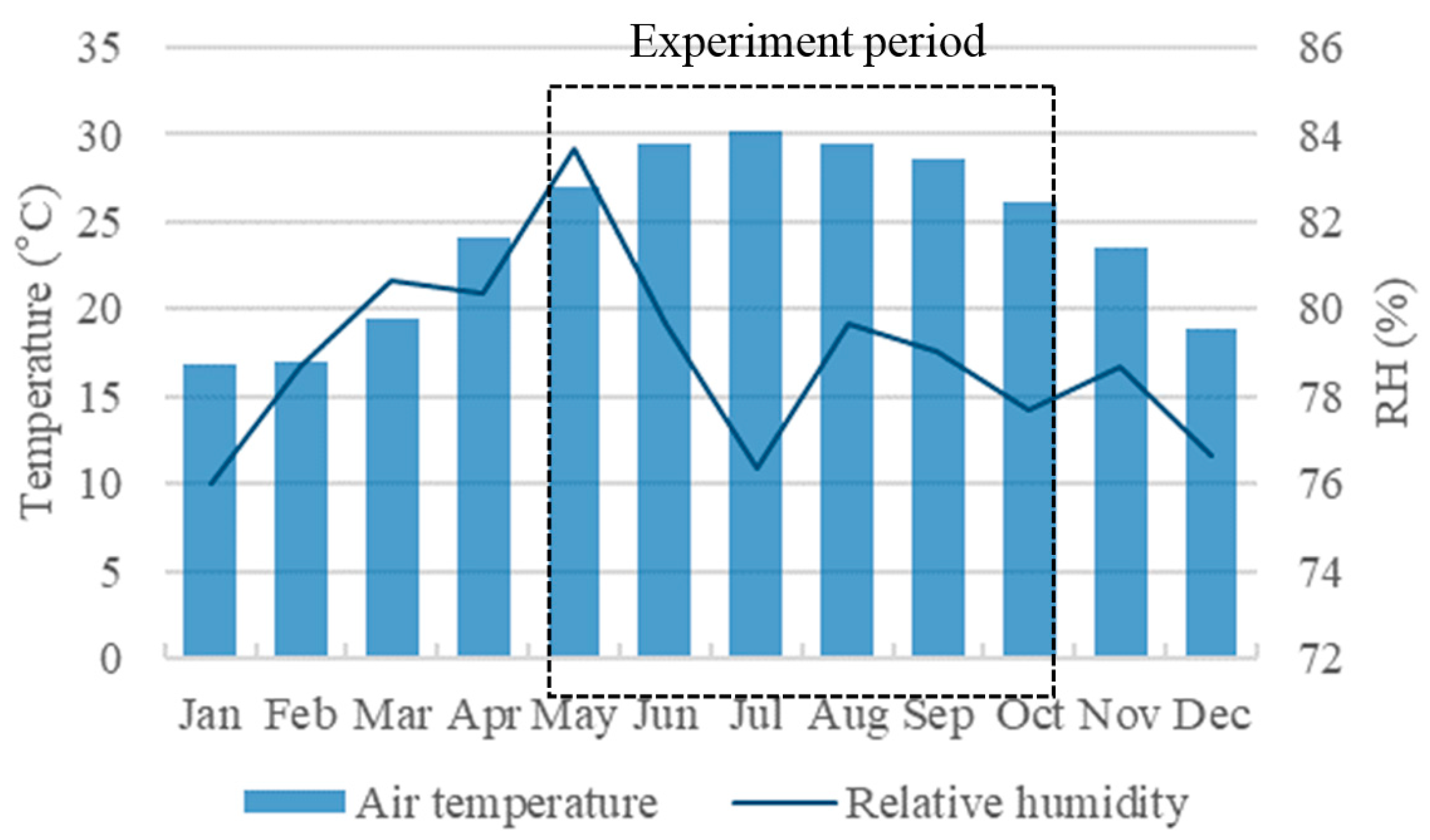
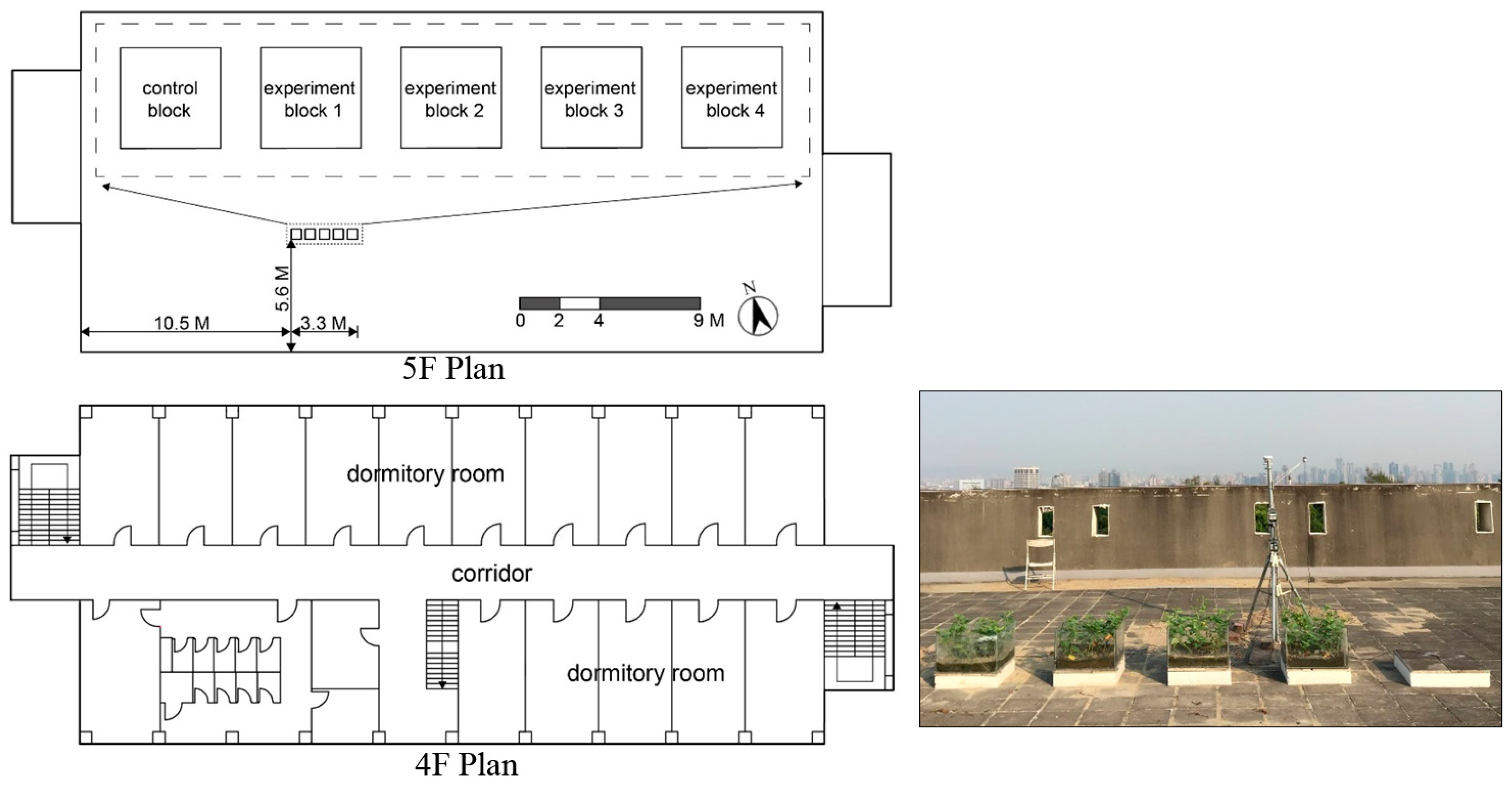
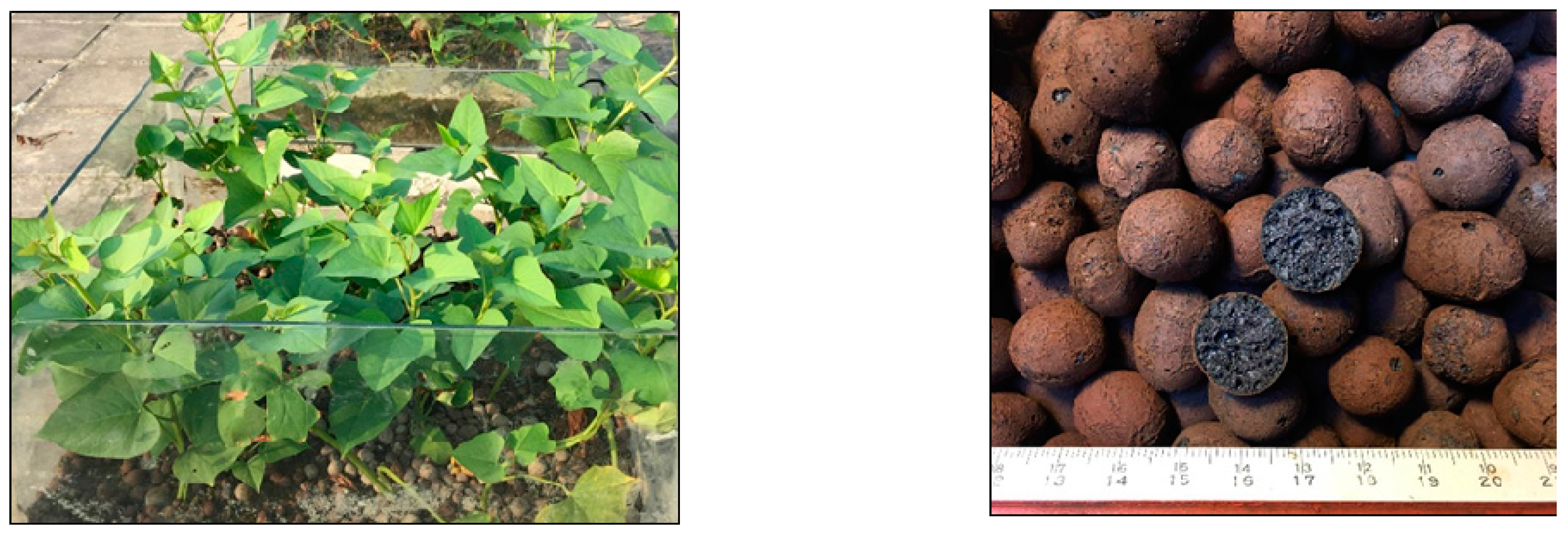
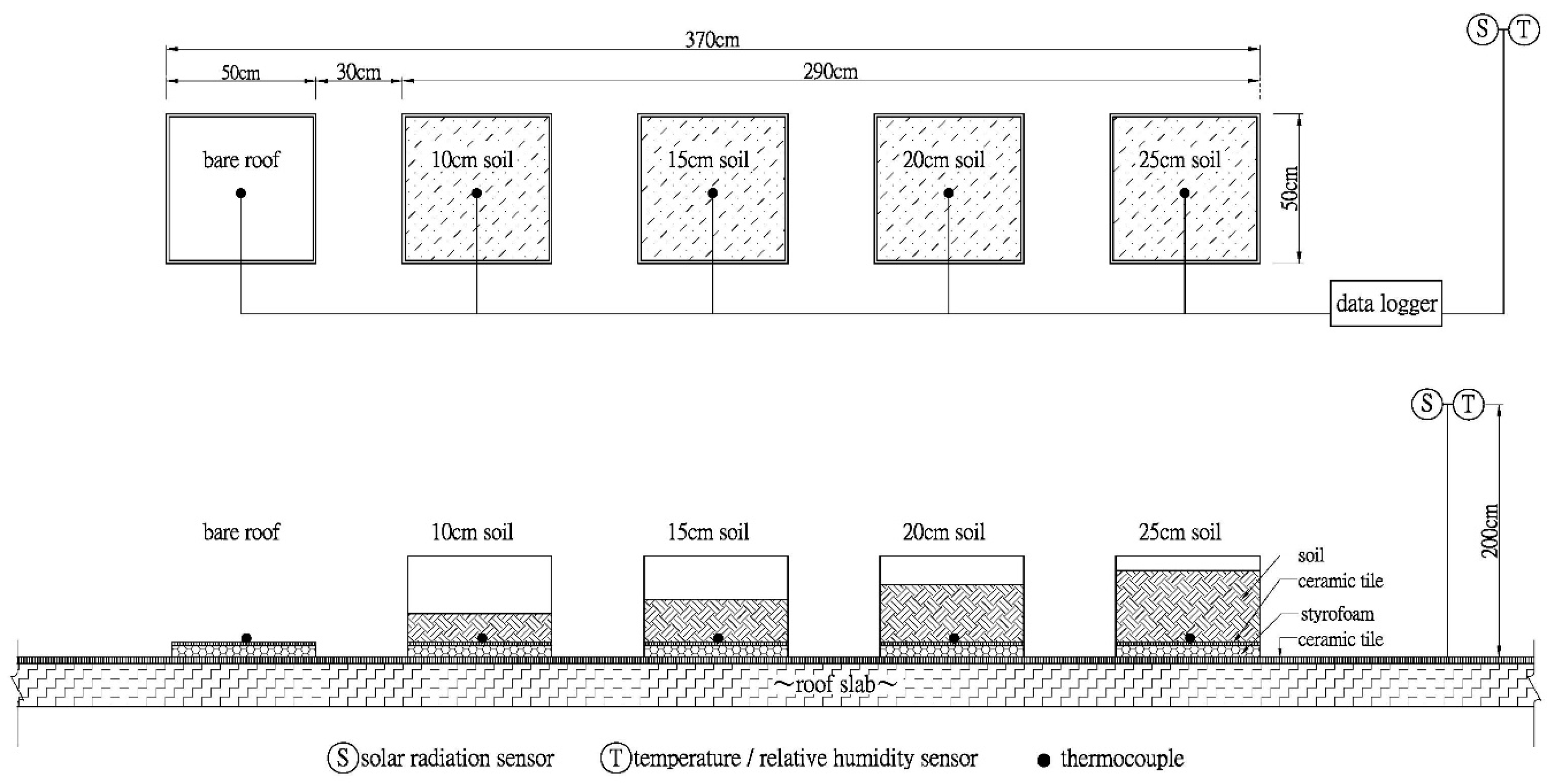
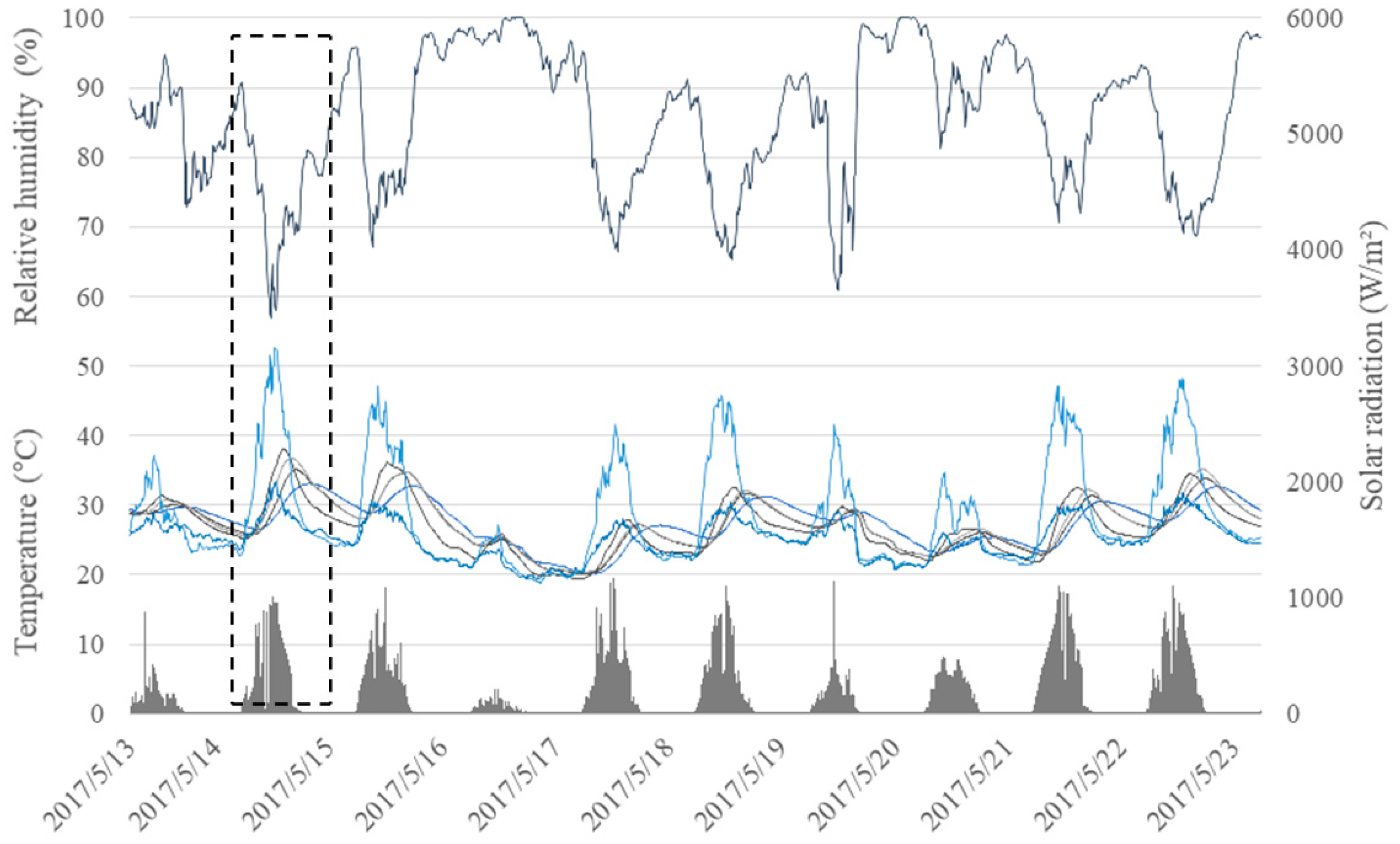
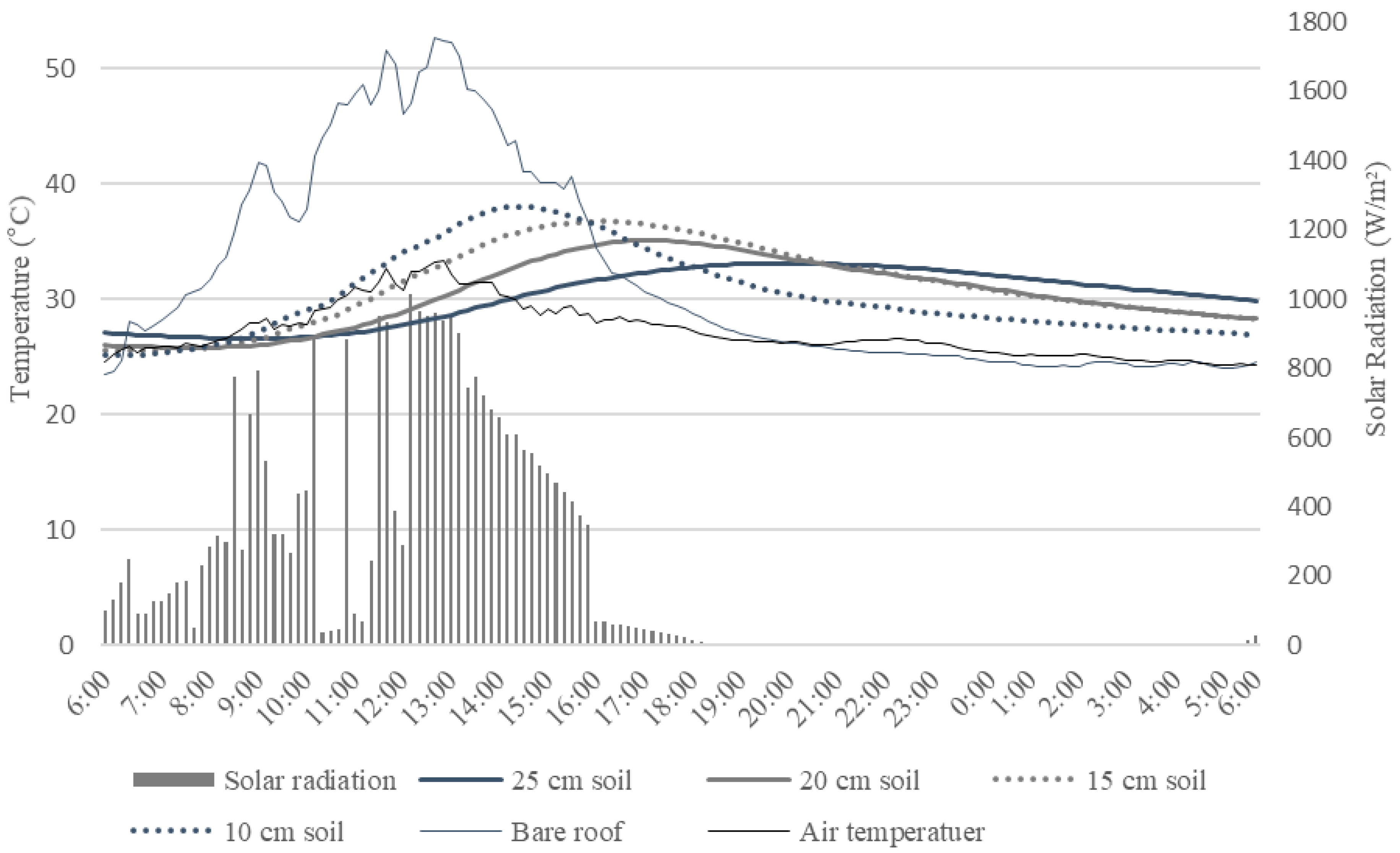
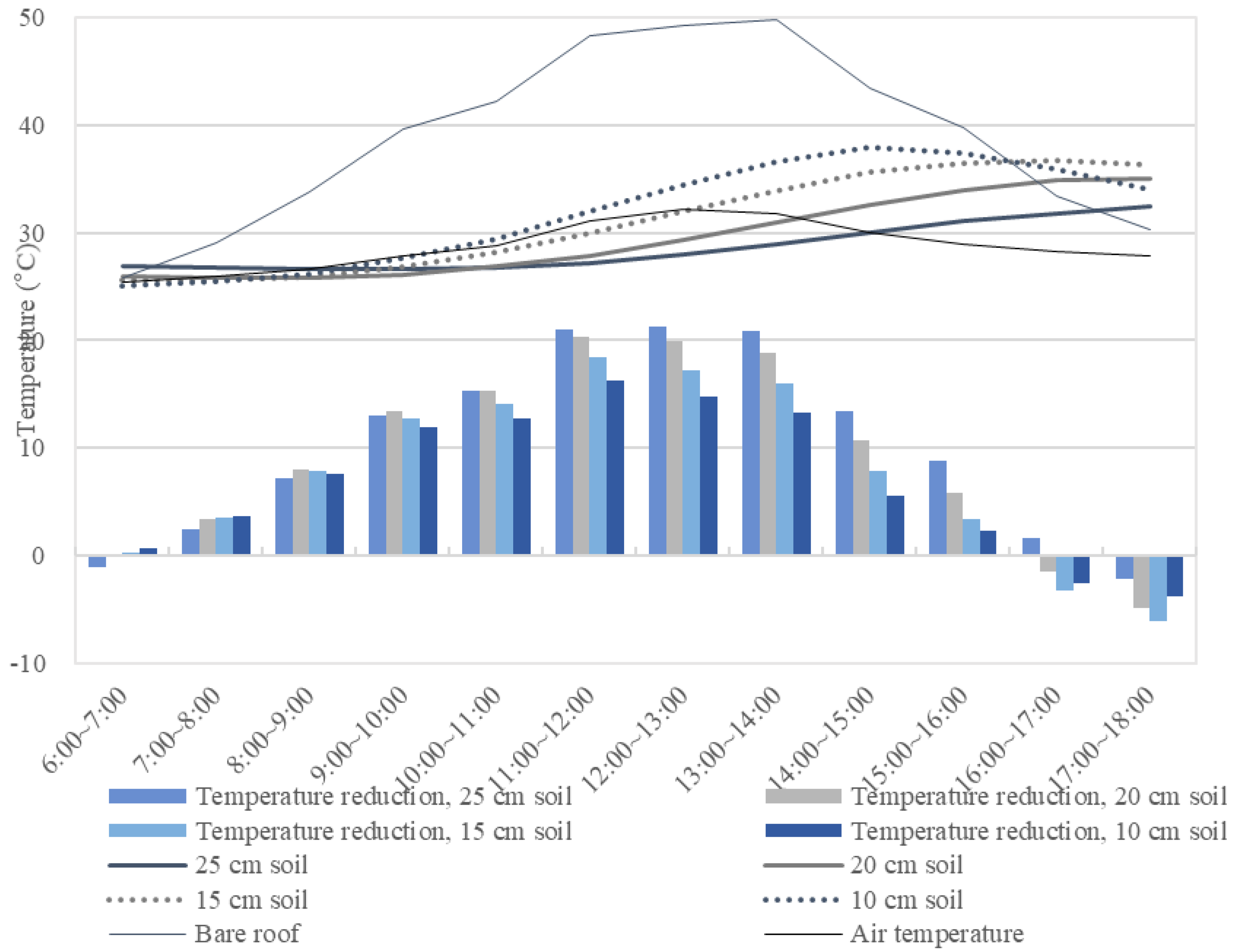


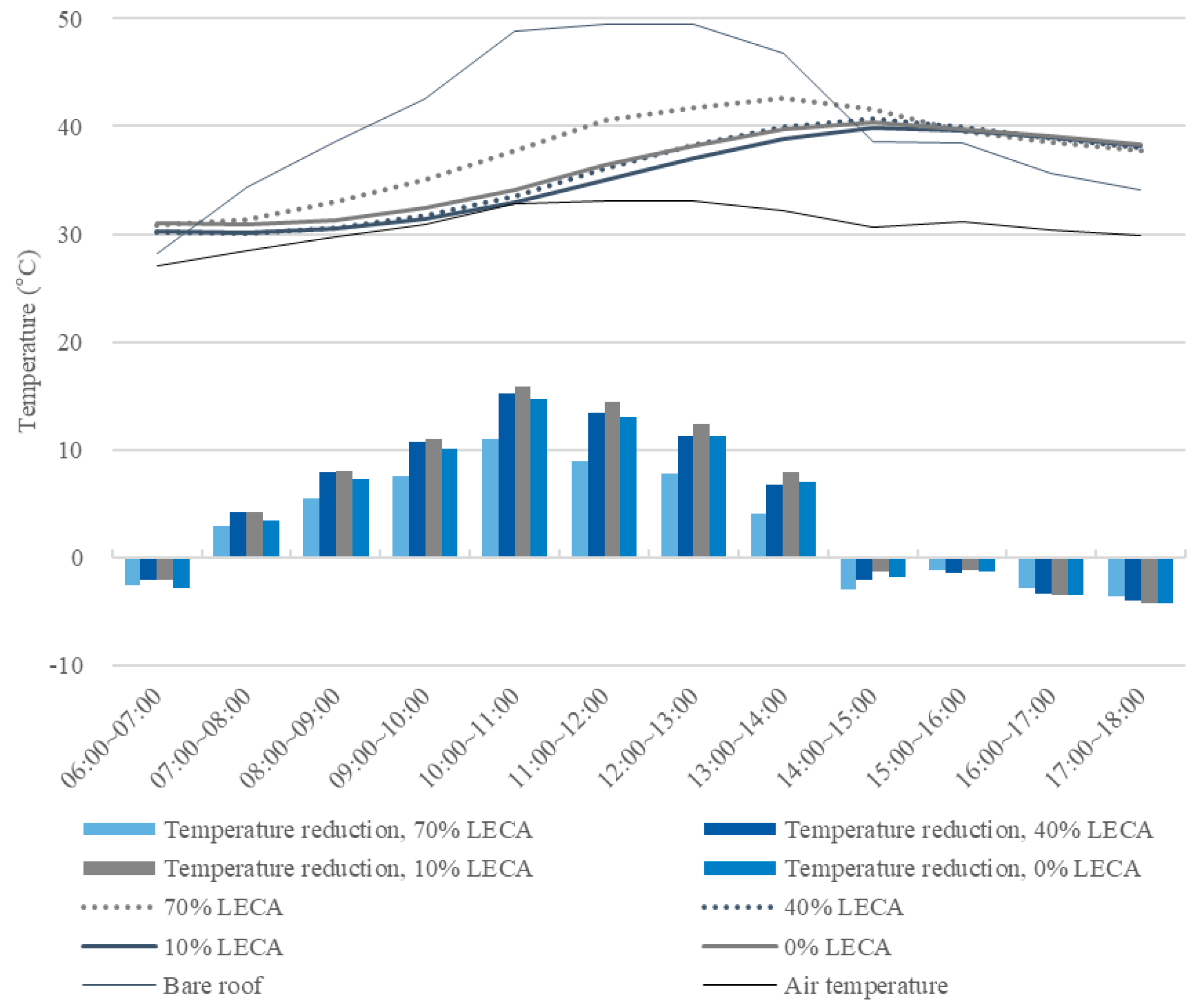
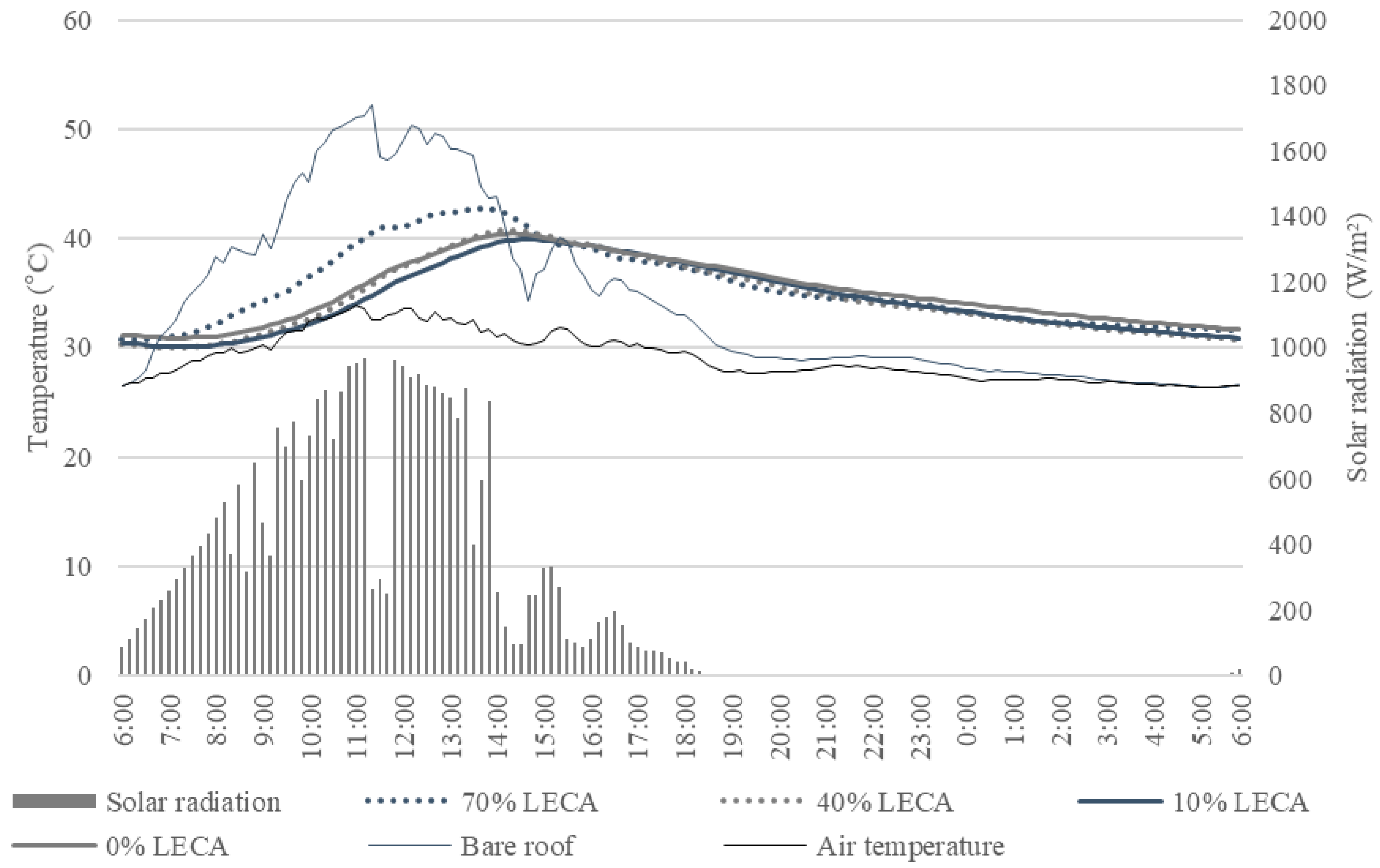

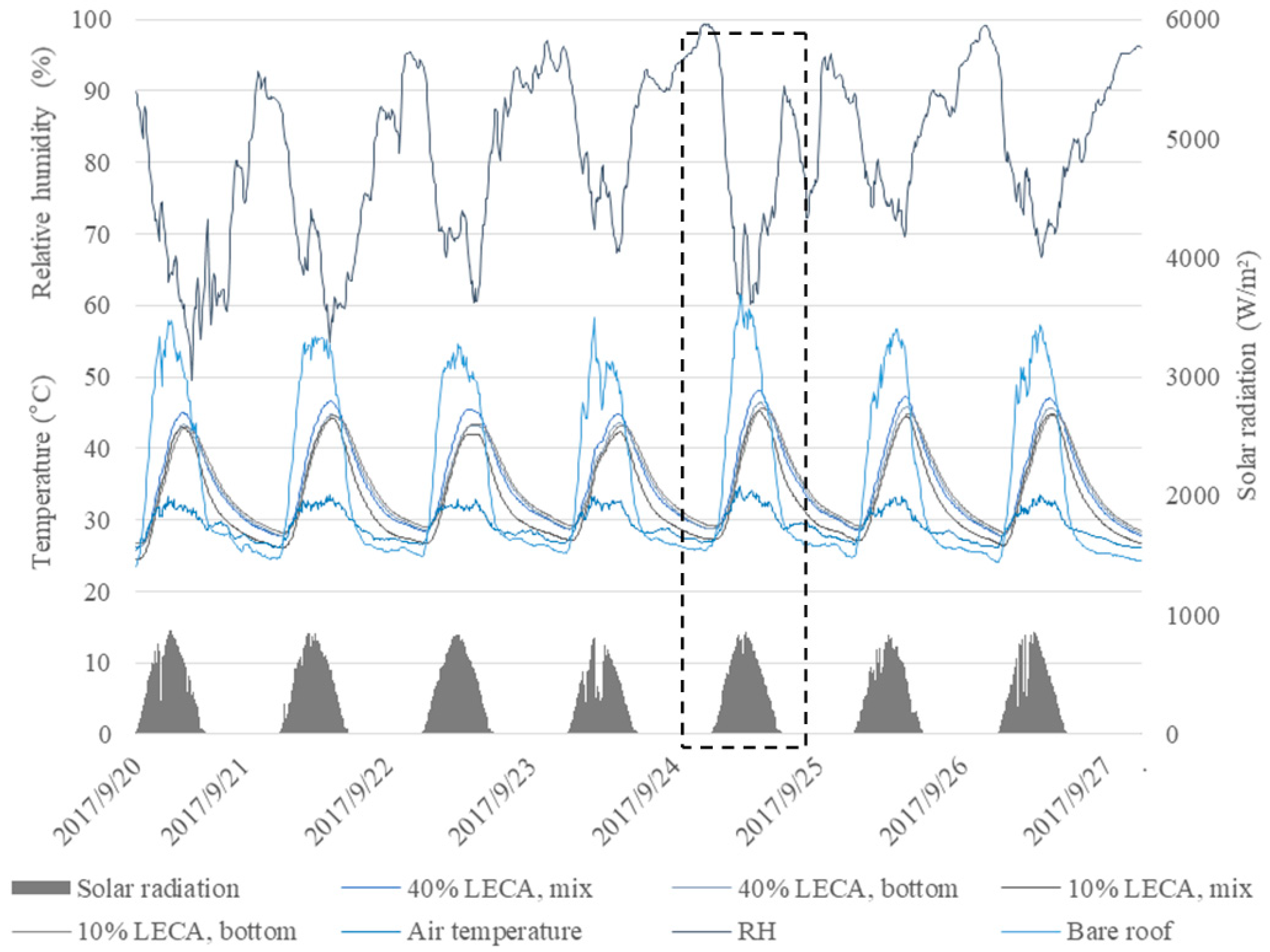
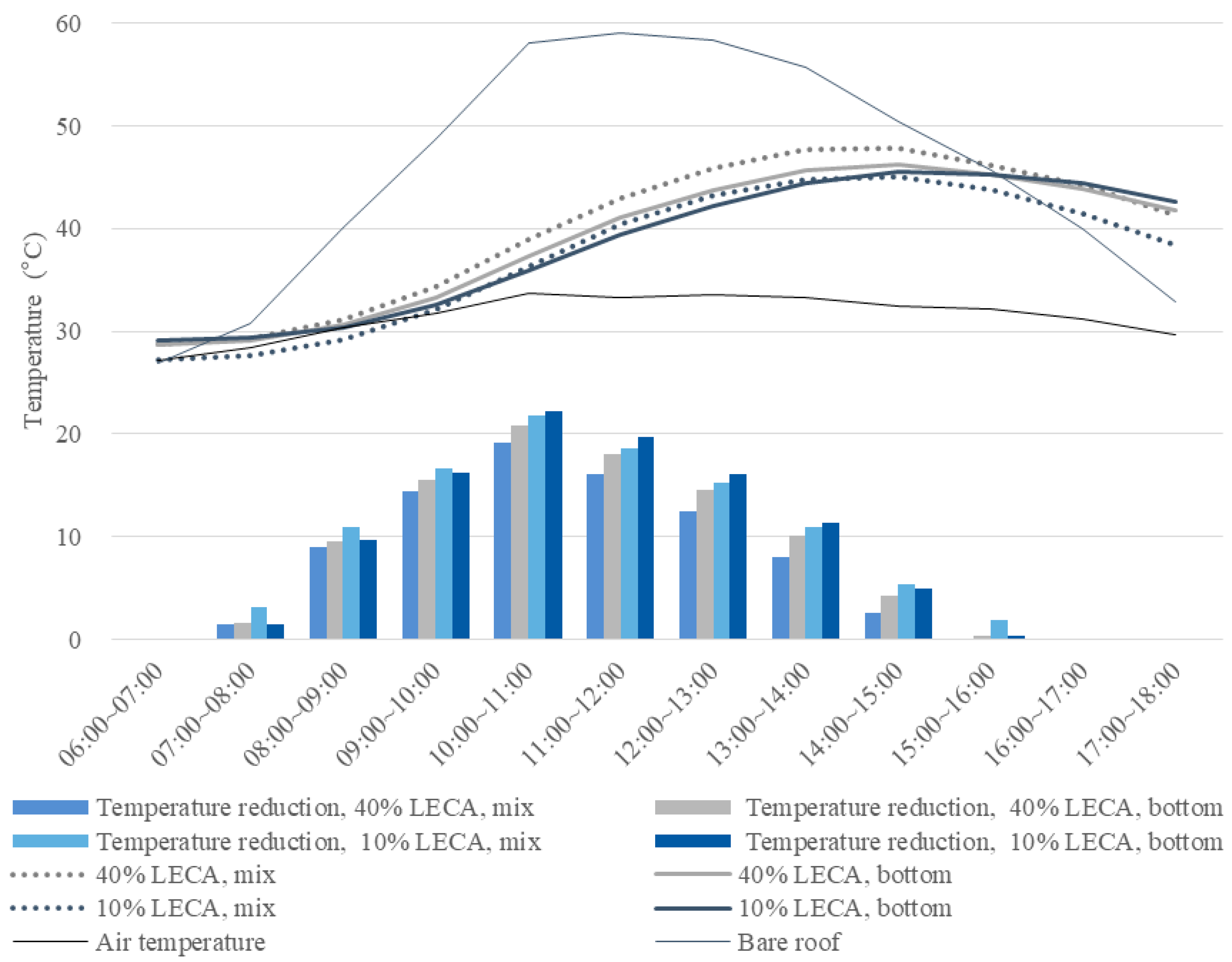
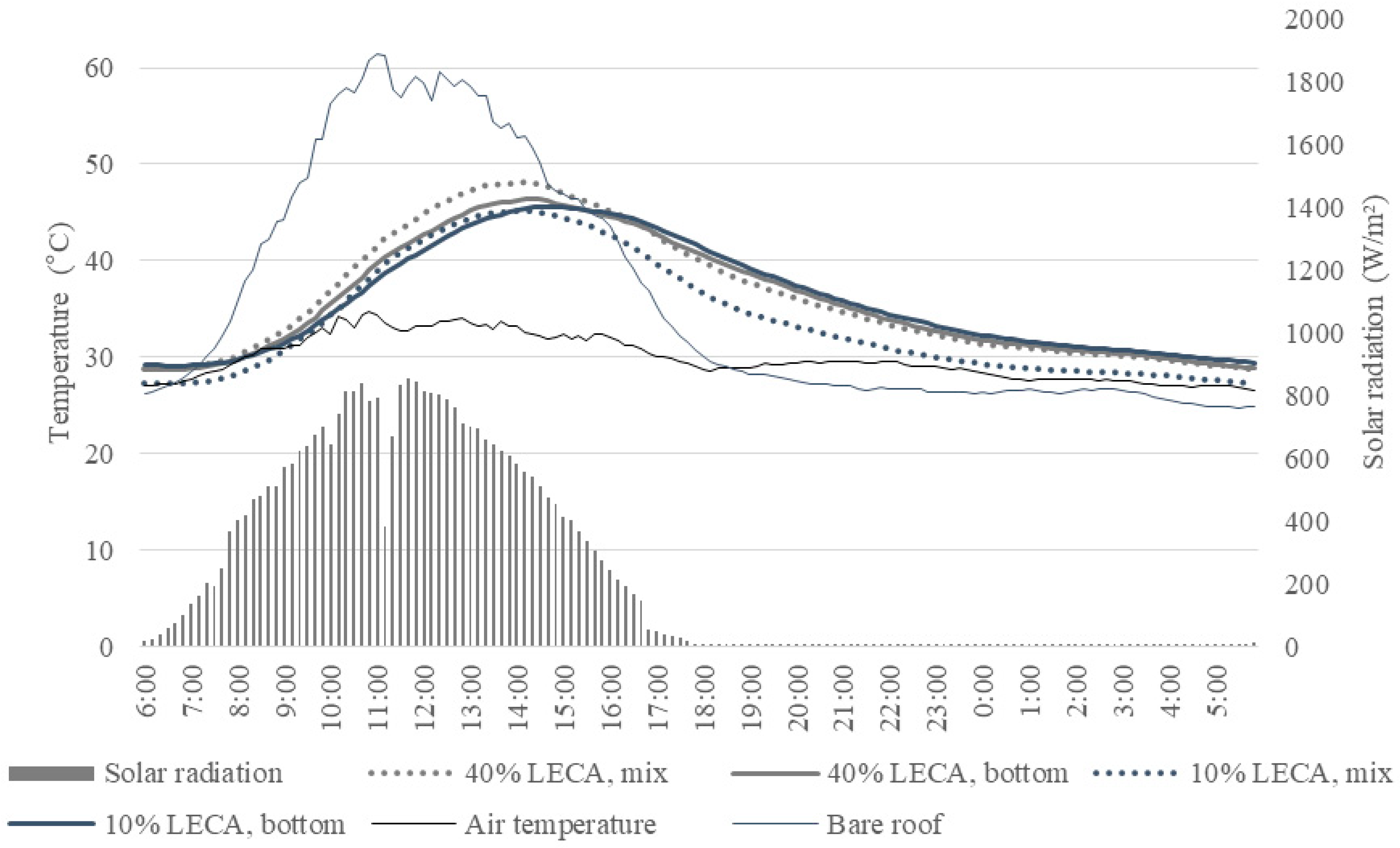

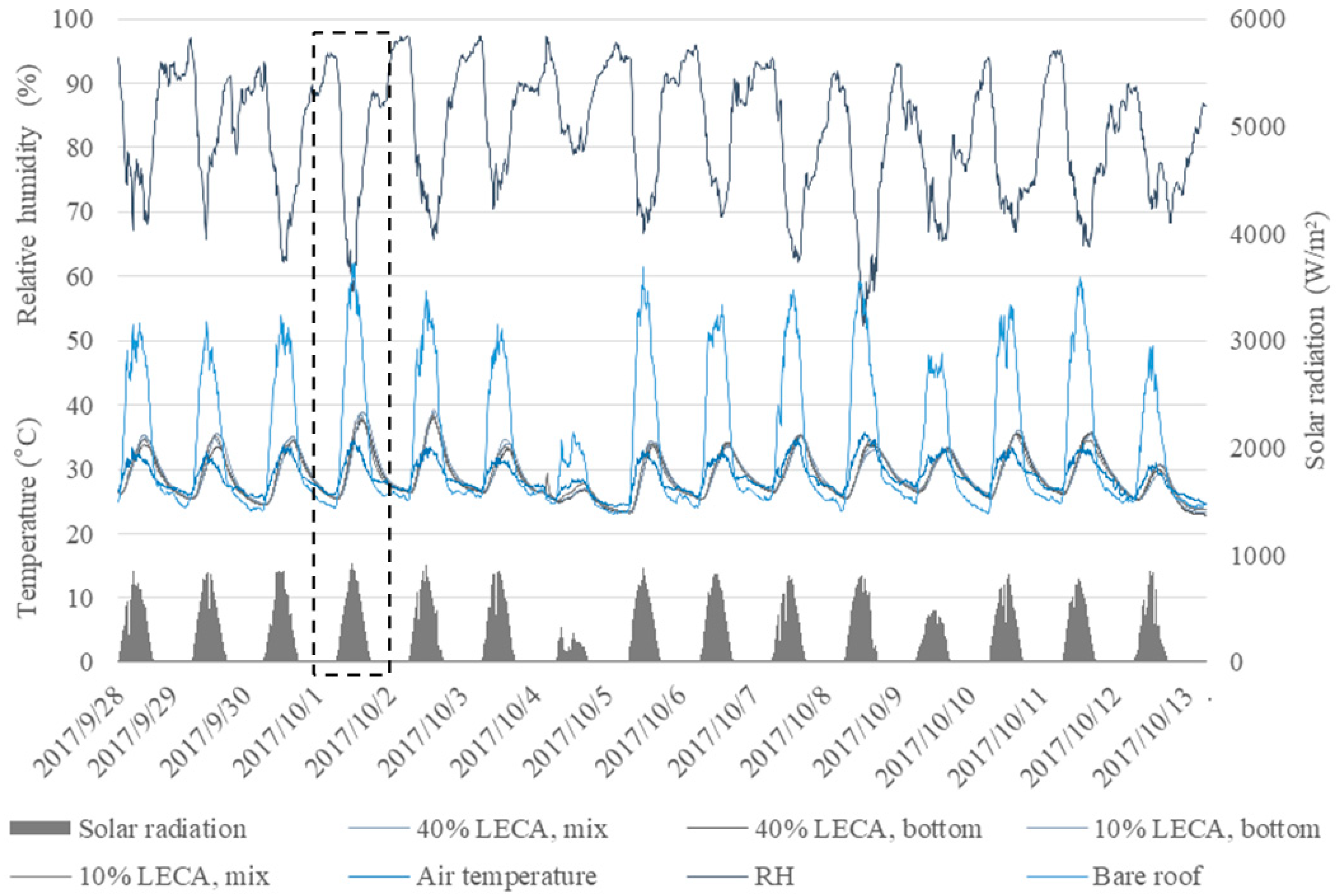
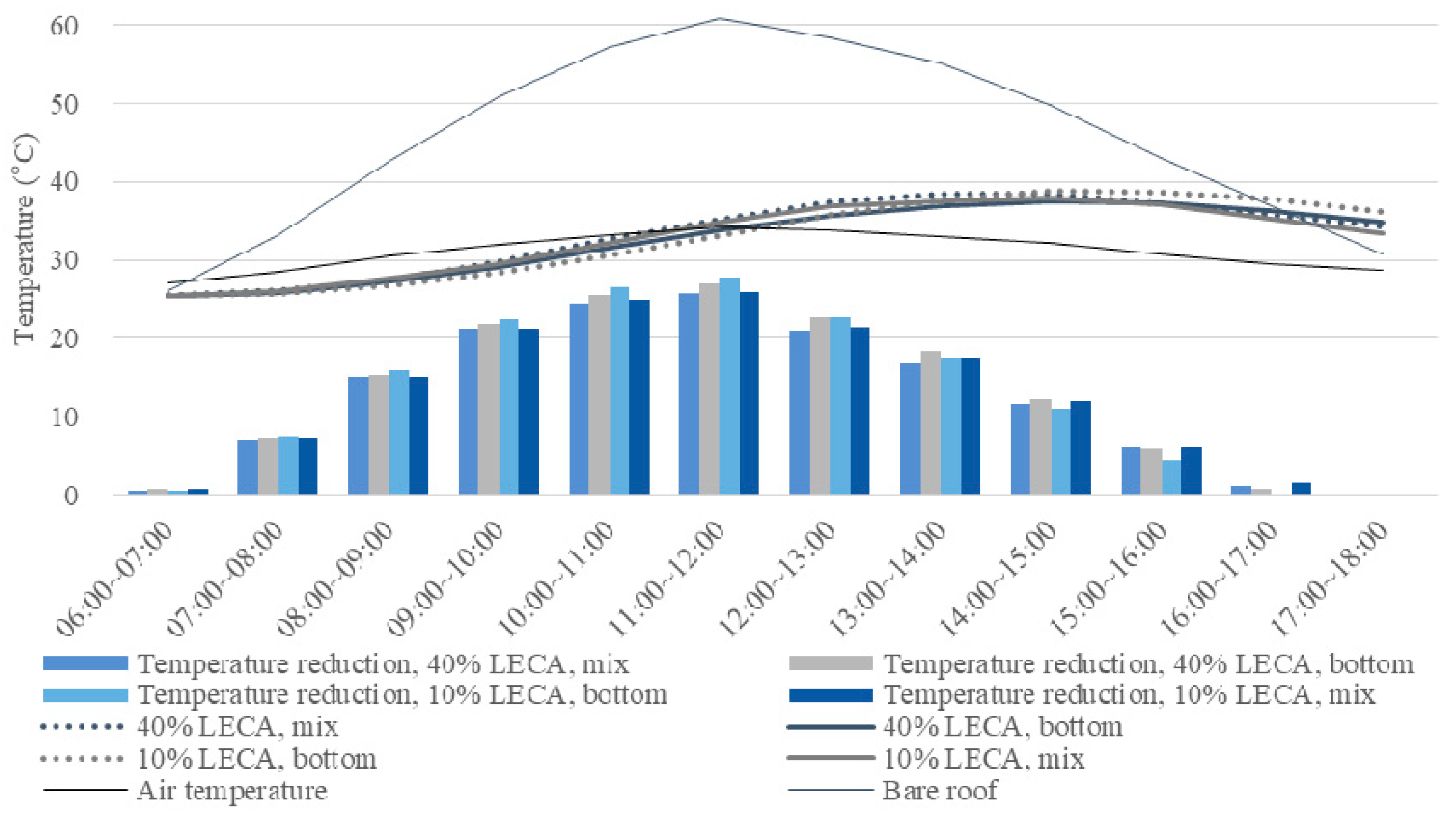
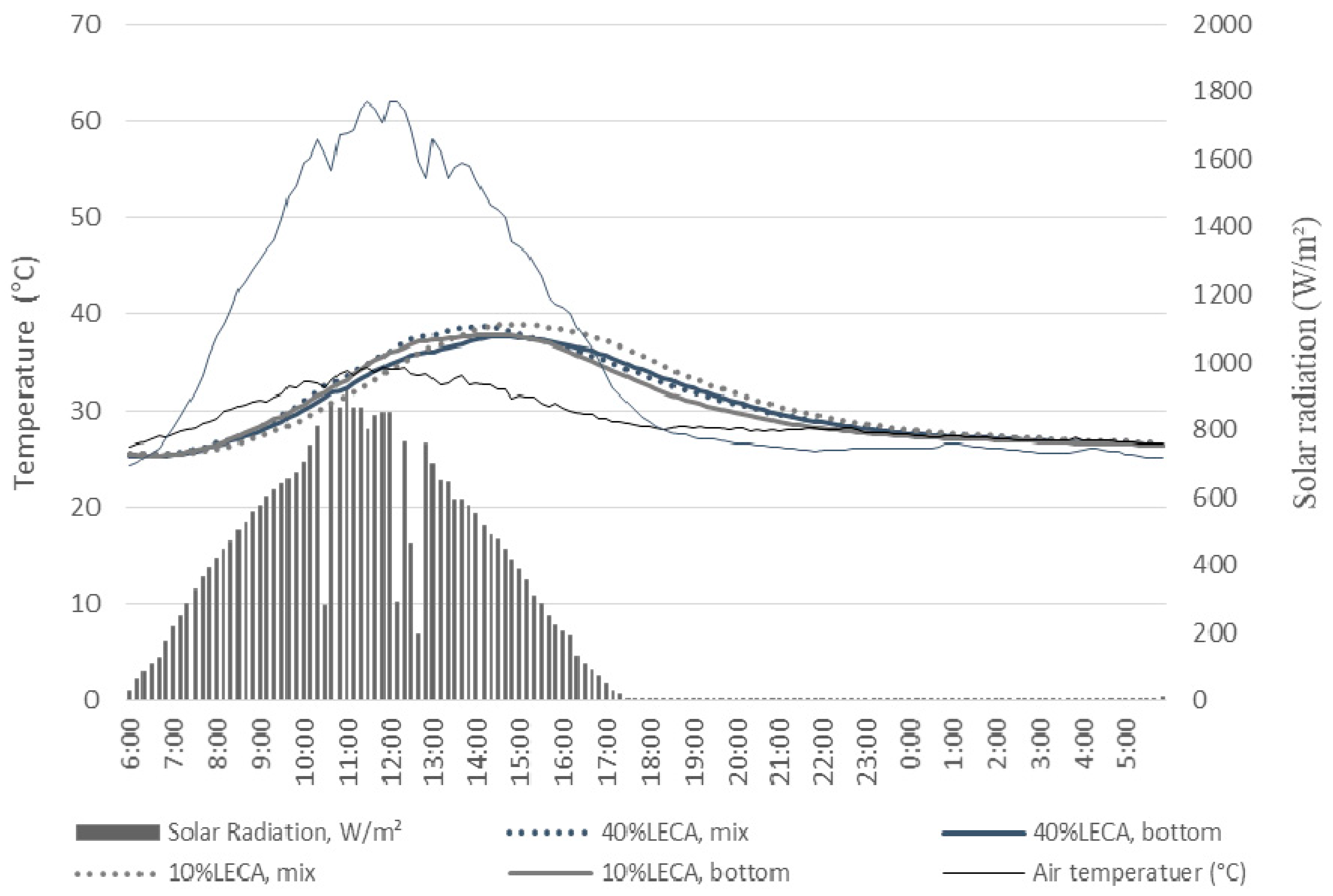
| Parameters | Equipment Used | Type | Measurement Range | Accuracy |
|---|---|---|---|---|
| Solar radiation | Solar radiation smart sensor (Silicon Pyranometer) | S-LIB-M003 | −40 to 75 °C | ±10 W/m2 or ±5%, whichever is greater in sunlight. Additional temperature induced error ±0.38 W/m2/°C from 25 °C |
| Air temperature & Relative humidity | 12-bit Temperature/Relative humidity smart sensor | S-THB-M002 | Temp: −40 to 75 °C, RH: 0% to 100% at −40 to 75 °C | Temp: +/− 0.21 °C from 0 to 50 °C; RH: +/− 2.5% from 10% to 90% RH (typical), to a maximum of +/− 3.5% including hysteresis at 25 °C; below 10% and above 90% ±5% typical |
| Temperature | 12-bit Temperature smart sensor | S-TMB-M002, S-TMB-M006 | −40 to 75 °C, sensor tip | < ±0.2 °C from 0 to 50 °C |
| − | Hobo micro station data logger | H21-002 | −20 to 50 °C with alkaline batteries, −40 to 70 °C with lithium batteries | 0 to 2 seconds for the first data point and ±5 seconds per week at 25 °C |
| First Stage | Value |
|---|---|
| Period of measurement | 13–23 May 2017 |
| Range of air temperature | 19.37–33.29 °C |
| Mean air temperature | 25.15 °C |
| Range of rooftop temperature | 18.82–52.67 °C |
| Mean rooftop temperature | 28.44 °C |
| Maximum solar radiation | 1170.60 W/m2 |
| Mean relative humidity | 85.54% |
| Date selected for further analysis (marked with dotted box) | 14–15 May 2017 |
| Thermocouple Position | 06:00–07:00 (°C) | 07:00–08:00 (°C) | 08:00–09:00 (°C) | 09:00–10:00 (°C) | 10:00–11:00 (°C) | 11:00–12:00 (°C) | 12:00–13:00 (°C) | 13:00–14:00 (°C) | 14:00–15:00 (°C) | 15:00–16:00 (°C) | 16:00–17:00 (°C) | 17:00–18:00 (°C) | |
|---|---|---|---|---|---|---|---|---|---|---|---|---|---|
| In the air | 25.43 | 25.90 | 26.57 | 27.85 | 28.86 | 31.14 | 32.14 | 31.81 | 30.07 | 28.96 | 28.25 | 27.85 | |
| Bare rooftop surface | 25.85 | 29.12 | 33.82 | 39.59 | 42.16 | 48.26 | 49.27 | 49.85 | 43.40 | 39.79 | 33.39 | 30.23 | |
| At the bottom | 10 cm soil, no plants | 25.13 | 25.46 | 26.18 | 27.72 | 29.48 | 32.02 | 34.49 | 36.60 | 37.91 | 37.45 | 35.91 | 34.00 |
| 15 cm soil, no plants | 25.55 | 25.63 | 25.95 | 26.83 | 28.13 | 29.90 | 32.02 | 33.89 | 35.59 | 36.47 | 36.70 | 36.32 | |
| 20 cm soil, no plants | 25.92 | 25.81 | 25.83 | 26.15 | 26.85 | 27.88 | 29.31 | 30.96 | 32.65 | 34.00 | 34.84 | 35.07 | |
| 25 cm soil, no plants | 26.96 | 26.76 | 26.59 | 26.57 | 26.80 | 27.24 | 27.97 | 28.92 | 30.04 | 31.04 | 31.82 | 32.41 | |
| Temperature Reduction | 10 cm soil, no plants | 0.73 | 3.66 | 7.64 | 11.87 | 12.68 | 16.24 | 14.79 | 13.25 | 5.49 | 2.35 | −2.52 | −3.77 |
| 15 cm soil, no plants | 0.30 | 3.49 | 7.87 | 12.76 | 14.03 | 18.36 | 17.26 | 15.97 | 7.81 | 3.33 | −3.31 | −6.09 | |
| 20 cm soil, no plants | −0.07 | 3.32 | 7.99 | 13.44 | 15.32 | 20.38 | 19.97 | 18.90 | 10.75 | 5.79 | −1.45 | −4.83 | |
| 25 cm soil, no plants | −1.11 | 2.37 | 7.23 | 13.02 | 15.36 | 21.02 | 21.30 | 20.93 | 13.36 | 8.75 | 1.57 | −2.18 | |
| Thermocouple Position | Average Temperature (°C) | Average Temperature Reduction (°C) | Additional Temperature Reduction due to Increased Soil Depth (°C) | Incremental Increase in Soil Depth (cm) | Marginal Temperature Reduction (°C) | |
|---|---|---|---|---|---|---|
| Air temperature | 29.18 | - | - | - | - | |
| Bare rooftop surface | 41.72 | - | - | - | - | |
| At the bottom | 10 cm soil, no plants | 30.28 | 11.45 | 11.45 | 10 | 1.15 |
| 15 cm soil, no plants | 28.91 | 12.82 | 1.37 | 5 | 0.27 | |
| 20 cm soil, no plants | 27.54 | 14.19 | 1.37 | 5 | 0.27 | |
| 25 cm soil, no plants | 27.26 | 14.46 | 0.28 | 5 | 0.06 | |
| Second Stage | Value |
|---|---|
| Period of measurement | 14–26 July 2017 |
| Range of air temperature | 25.53–33.94 °C |
| Mean air temperature | 29.15 °C |
| Range of rooftop temperature | 25.45–52.24 °C |
| Mean rooftop temperature | 33.96 °C |
| Maximum solar radiation | 1138.10 W/m2 |
| Mean relative humidity | 80.88% |
| Date selected for further analysis (marked with dotted box) | 25–26 July 2017 |
| Thermocouple Position | 06:00–07:00 (°C) | 07:00–08:00 (°C) | 08:00–09:00 (°C) | 09:00–10:00 (°C) | 10:00–11:00 (°C) | 11:00–12:00 (°C) | 12:00–13:00 (°C) | 13:00–14:00 (°C) | 14:00–15:00 (°C) | 15:00–16:00 (°C) | 16:00–17:00 (°C) | 17:00–18:00 (°C) | |
|---|---|---|---|---|---|---|---|---|---|---|---|---|---|
| In the air | 27.04 | 28.49 | 29.73 | 30.93 | 32.87 | 33.15 | 33.06 | 32.16 | 30.70 | 31.20 | 30.37 | 29.90 | |
| Bare rooftop surface | 28.20 | 34.32 | 38.59 | 42.53 | 48.78 | 49.47 | 49.51 | 46.73 | 38.59 | 38.41 | 35.64 | 34.09 | |
| At the bottom | 0% LECA, no plants | 31.05 | 30.93 | 31.32 | 32.40 | 34.08 | 36.42 | 38.26 | 39.74 | 40.37 | 39.74 | 39.04 | 38.28 |
| 10% LECA, no plants | 30.30 | 30.13 | 30.53 | 31.47 | 32.91 | 35.02 | 37.08 | 38.80 | 39.83 | 39.62 | 39.04 | 38.26 | |
| 40% LECA, no plants | 30.20 | 30.11 | 30.64 | 31.80 | 33.57 | 36.07 | 38.21 | 39.96 | 40.68 | 39.87 | 38.97 | 38.01 | |
| 70% LECA, no plants | 30.80 | 31.35 | 33.06 | 35.01 | 37.77 | 40.54 | 41.74 | 42.60 | 41.60 | 39.55 | 38.51 | 37.72 | |
| Temperature Reduction | 0% LECA, no plants | −2.85 | 3.39 | 7.27 | 10.13 | 14.70 | 13.05 | 11.25 | 6.98 | −1.78 | −1.33 | −3.40 | −4.19 |
| 10% LECA, no plants | −2.10 | 4.19 | 8.07 | 11.06 | 15.87 | 14.46 | 12.43 | 7.93 | −1.24 | −1.21 | −3.40 | −4.17 | |
| 40% LECA, no plants | −2.00 | 4.21 | 7.96 | 10.73 | 15.21 | 13.40 | 11.30 | 6.77 | −2.09 | −1.46 | −3.33 | −3.92 | |
| 70% LECA, no plants | −2.60 | 2.96 | 5.54 | 7.52 | 11.01 | 8.93 | 7.77 | 4.12 | −3.01 | −1.14 | −2.88 | −3.64 | |
| Thermocouple Position | Average Temperature (°C) | Range of Temperature (°C) | Difference in Temperature (°C) | Heat Amplitude Reduction | |
|---|---|---|---|---|---|
| In the air | 29.13 | 26.33–33.94 | 7.61 | - | |
| Bare rooftop surface | 34.35 | 26.38–52.24 | 25.86 | - | |
| At the bottom | 0% LECA, no plants | 35.13 | 30.90–40.46 | 9.56 | 63.03% |
| 10% LECA, no plants | 34.46 | 30.09–39.94 | 9.85 | 61.91% | |
| 40% LECA, no plants | 34.55 | 30.04–40.78 | 10.74 | 58.47% | |
| 70% LECA, no plants | 35.56 | 30.72–42.77 | 12.05 | 53.40% | |
| Third Stage | Value |
|---|---|
| Period of measurement | 20–27 September 2017 |
| Range of air temperature | 25.74–34.76 °C |
| Mean air temperature | 29.29 °C |
| Range of rooftop temperature | 23.55–61.49 °C |
| Mean rooftop temperature | 35.42 °C |
| Maximum solar radiation | 873.10 W/m2 |
| Mean relative humidity | 80.93% |
| Date selected for further analysis (marked with dotted box) | 24–25 September 2017 |
| Thermocouple Position | 06:00–07:00 (°C) | 07:00–08:00 (°C) | 08:00–09:00 (°C) | 09:00–10:00 (°C) | 10:00–11:00 (°C) | 11:00–12:00 (°C) | 12:00–13:00 (°C) | 13:00–14:00 (°C) | 14:00–15:00 (°C) | 15:00–16:00 (°C) | 16:00–17:00 (°C) | 17:00–18:00 (°C) | |
|---|---|---|---|---|---|---|---|---|---|---|---|---|---|
| In the air | 27.19 | 28.44 | 30.40 | 31.80 | 33.76 | 33.23 | 33.60 | 33.35 | 32.42 | 32.19 | 31.21 | 29.67 | |
| Bare rooftop surface | 26.90 | 30.75 | 40.10 | 48.77 | 58.08 | 59.11 | 58.38 | 55.77 | 50.42 | 45.67 | 39.95 | 32.81 | |
| At the bottom | 10% LECA, bottom, no plants | 29.13 | 29.32 | 30.40 | 32.59 | 35.90 | 39.38 | 42.26 | 44.42 | 45.51 | 45.29 | 44.39 | 42.55 |
| 10% LECA, mix, no plants | 27.26 | 27.62 | 29.14 | 32.11 | 36.24 | 40.46 | 43.19 | 44.80 | 45.00 | 43.79 | 41.50 | 38.36 | |
| 40% LECA, bottom, no plants | 28.74 | 29.12 | 30.60 | 33.28 | 37.26 | 41.06 | 43.78 | 45.74 | 46.24 | 45.27 | 43.93 | 41.80 | |
| 40% LECA, mix, no plants | 28.78 | 29.34 | 31.19 | 34.31 | 38.88 | 42.99 | 45.96 | 47.72 | 47.84 | 46.23 | 44.21 | 41.36 | |
| Temperature reduction | 10% LECA, bottom, no plants | −2.22 | 1.44 | 9.70 | 16.18 | 22.18 | 19.74 | 16.12 | 11.36 | 4.91 | 0.38 | −4.44 | −9.75 |
| 10% LECA, mix, no plants | −0.36 | 3.14 | 10.96 | 16.66 | 21.84 | 18.65 | 15.19 | 10.97 | 5.42 | 1.88 | −1.55 | −5.55 | |
| 40% LECA, bottom, no plants | −1.83 | 1.64 | 9.50 | 15.49 | 20.83 | 18.06 | 14.60 | 10.04 | 4.18 | 0.40 | −3.98 | −9.00 | |
| 40% LECA, mix, no plants | −1.88 | 1.41 | 8.91 | 14.47 | 19.21 | 16.12 | 12.42 | 8.06 | 2.58 | −0.56 | −4.26 | −8.55 | |
| Thermocouple Position | Average Temperature (°C) | Range of Temperature (°C) | Difference inTemperature (°C) | Heat Amplitude Reduction | |
|---|---|---|---|---|---|
| In the air | 29.86 | 26.50–34.76 | 8.26 | - | |
| Bare rooftop surface | 36.11 | 24.77–61.49 | 36.72 | - | |
| At the bottom | 10% LECA, bottom, no plants | 35.79 | 29.09–45.62 | 16.53 | 54.98% |
| 10% LECA, mix, no plants | 33.89 | 27.19–45.19 | 18.00 | 50.98% | |
| 40% LECA, bottom, no plants | 35.96 | 28.72–46.39 | 17.67 | 51.88% | |
| 40% LECA, mix, no plants | 36.23 | 28.72–48.07 | 19.35 | 47.30% | |
| Fourth Stage | Value |
|---|---|
| Period of measurement | 28 September 2017–13 October 2017 |
| Range of air temperature | 24.12–35.72 °C |
| Mean air temperature | 28.80 °C |
| Range of rooftop temperature | 23.04–61.90 °C |
| Mean rooftop temperature | 33.80 °C |
| Maximum solar radiation | 921.90 W/m2 |
| Mean relative humidity | 82.15% |
| Date selected for further analysis (marked with dotted box) | 1–2 October 2017 |
| Thermocouple Position | 06:00–07:00 (°C) | 07:00–08:00 (°C) | 08:00–09:00 (°C) | 09:00–10:00 (°C) | 10:00–11:00 (°C) | 11:00–12:00 (°C) | 12:00–13:00 (°C) | 13:00–14:00 (°C) | 14:00–15:00 (°C) | 15:00–16:00 (°C) | 16:00–17:00 (°C) | 17:00–18:00 (°C) | |
|---|---|---|---|---|---|---|---|---|---|---|---|---|---|
| In the air | 26.86 | 28.18 | 30.21 | 31.65 | 33.00 | 34.12 | 34.03 | 33.08 | 32.32 | 31.07 | 29.74 | 28.70 | |
| Bare rooftop surface | 25.43 | 31.57 | 41.23 | 49.19 | 56.61 | 60.32 | 58.98 | 55.83 | 50.96 | 44.17 | 38.07 | 31.28 | |
| At the bottom | 10% LECA, bottom, with plants | 25.50 | 25.68 | 26.53 | 28.04 | 30.14 | 32.60 | 35.28 | 37.33 | 38.69 | 38.72 | 37.91 | 36.40 |
| 10% LECA, mix, with plants | 25.37 | 25.80 | 27.24 | 29.25 | 31.70 | 34.46 | 36.68 | 37.49 | 37.84 | 37.25 | 35.61 | 33.61 | |
| 40% LECA, bottom, with plants | 25.31 | 25.74 | 26.99 | 28.73 | 31.13 | 33.45 | 35.51 | 36.62 | 37.55 | 37.31 | 36.44 | 34.97 | |
| 40% LECA, mix, with plants | 25.57 | 25.98 | 27.17 | 29.28 | 32.19 | 34.69 | 37.09 | 38.24 | 38.46 | 37.35 | 36.02 | 34.46 | |
| Temperature reduction | 10% LECA, bottom, with plants | −0.07 | 5.90 | 14.70 | 21.15 | 26.47 | 27.73 | 23.70 | 18.50 | 12.27 | 5.45 | 0.16 | −5.13 |
| 10% LECA, mix, with plants | 0.06 | 5.77 | 13.99 | 19.95 | 24.90 | 25.87 | 22.31 | 18.35 | 13.12 | 6.93 | 2.46 | −2.33 | |
| 40% LECA, bottom, with plants | 0.12 | 5.84 | 14.24 | 20.46 | 25.47 | 26.87 | 23.47 | 19.22 | 13.41 | 6.86 | 1.64 | −3.69 | |
| 40% LECA, mix, with plants | -0.14 | 5.59 | 14.06 | 19.91 | 24.42 | 25.64 | 21.89 | 17.60 | 12.50 | 6.82 | 2.06 | −3.18 | |
| Thermocouple Position | Average Temperature (°C) | Range of Temperature (°C) | Difference in Temperature (°C) | Heat Amplitude Reduction | |
|---|---|---|---|---|---|
| In the air | 29.30 | 26.26–34.41 | 8.15 | - | |
| Bare rooftop surface | 35.77 | 24.29–61.90 | 37.61 | - | |
| At the bottom | 10% LECA, bottom, with plants | 30.89 | 25.48–38.90 | 13.42 | 64.32% |
| 10% LECA, mix, with plants | 30.36 | 25.36–37.87 | 12.51 | 66.74% | |
| 40% LECA, bottom, with plants | 30.51 | 25.28–37.65 | 12.37 | 67.11% | |
| 40% LECA, mix, with plants | 30.81 | 25.55–38.64 | 13.09 | 65.20% | |
| Stage | Treatment | Average Air Temperature (°C) | Average Rooftop Temperature Reduction (°C) | Conclusions |
|---|---|---|---|---|
| First stage | 0% LECA, 10 cm | 29.18 | 11.45 |
|
| 0% LECA, 15 cm | 12.82 | |||
| 0% LECA, 20 cm | 14.19 | |||
| 0% LECA, 25 cm | 14.46 | |||
| Second stage | 0% LECA, 10 cm, bottom, no plant | 31.48 | 9.54 |
|
| 10% LECA, 10 cm, bottom, no plant | 10.57 | |||
| 40% LECA, 10 cm, bottom, no plant | 9.94 | |||
| 70% LECA, 10 cm, bottom, no plant | 6.84 | |||
| Third stage | 10% LECA, 10 cm, bottom, no plant | 32.08 | 13.82 |
|
| 10% LECA, 10 cm, mixed, no plant | 13.92 | |||
| 40% LECA, 10 cm, bottom, no plant | 12.88 | |||
| 40% LECA, 10 cm, mixed, no plant | 11.51 | |||
| Fourth stage | 10% LECA, 10 cm, bottom, with plants | 32.04 | 19.73 |
|
| 10% LECA, 10 cm, mixed, with plants | 18.73 | |||
| 40% LECA, 10 cm, bottom, with plants | 19.37 | |||
| 40% LECA, 10 cm, mixed, with plants | 18.44 |
| The Roofs with LECA Laid at the Bottom and Without Plants (Decision) | Unit Weight of Growth Medium Before Irrigation (kg/m2) | Unit Weight of Growth Medium after Irrigation (kg/m2) | Saturated Water Weight (kg) | Estimated Unit Cost ($US Dollars/m2) | Total Weight before Irrigation (kg) (per Unit Building, Green Roof Area 42 m2 or 452 ft2) | Total Weight after Irrigation (kg) (per Unit Building, Green Roof Area 42 m2 or 452 ft2) | Estimated Total Cost of Growth Medium per Unit Building ($US dollar) | Average Rooftop Temperature Reduction (°C) | Heat Amplitude Reduction (%) |
|---|---|---|---|---|---|---|---|---|---|
| 0% LECA roof, (benchmark) | 81.27 | 135.95 | 54.68 | 21.67 | 3413.34 | 5709.90 | 910.14 | 9.54 | 63.03 |
| 10% LECA roof (preferred) | 76.71 | 126.38 | 49.67 | 23.07 | 3221.82 (cut by 191.52 kg, 5.6%, 3 adults) | 5307.96 (cut by 401.94 kg, 7.0%, 7 adults) | 968.94 (US$58.8 more) | 10.57 | 61.91 |
| 40% LECA roof (preferred) | 63.02 | 97.69 | 34.67 | 27.26 | 2646.84 (cut by 766.50 kg, 22.5%, 13 adults) | 4102.98 (cut by 1606.92 kg, 28.1%, 27 adults) | 1144.92 (US$234.8 more) | 9.94 | 58.47 |
| 70% LECA roof (not preferred) | 49.32 | 69.00 | 19.68 | 31.44 | 2071.44 | 2898.00 | 1320.48 | 6.84 | 53.40 |
© 2019 by the authors. Licensee MDPI, Basel, Switzerland. This article is an open access article distributed under the terms and conditions of the Creative Commons Attribution (CC BY) license (http://creativecommons.org/licenses/by/4.0/).
Share and Cite
Huang, Y.-Y.; Ma, T.-J. Using Edible Plant and Lightweight Expanded Clay Aggregate (LECA) to Strengthen the Thermal Performance of Extensive Green Roofs in Subtropical Urban Areas. Energies 2019, 12, 424. https://doi.org/10.3390/en12030424
Huang Y-Y, Ma T-J. Using Edible Plant and Lightweight Expanded Clay Aggregate (LECA) to Strengthen the Thermal Performance of Extensive Green Roofs in Subtropical Urban Areas. Energies. 2019; 12(3):424. https://doi.org/10.3390/en12030424
Chicago/Turabian StyleHuang, Yi-Yu, and Tien-Jih Ma. 2019. "Using Edible Plant and Lightweight Expanded Clay Aggregate (LECA) to Strengthen the Thermal Performance of Extensive Green Roofs in Subtropical Urban Areas" Energies 12, no. 3: 424. https://doi.org/10.3390/en12030424
APA StyleHuang, Y.-Y., & Ma, T.-J. (2019). Using Edible Plant and Lightweight Expanded Clay Aggregate (LECA) to Strengthen the Thermal Performance of Extensive Green Roofs in Subtropical Urban Areas. Energies, 12(3), 424. https://doi.org/10.3390/en12030424




